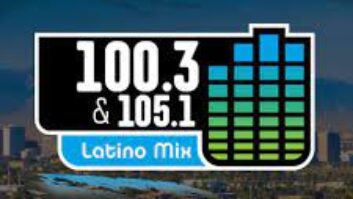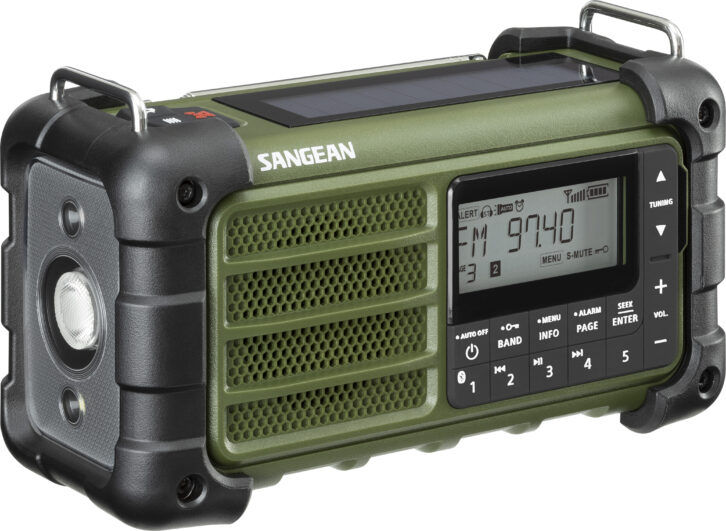
It is risky to manufacture a product that tries to do everything, but the MMR-99 by Sangean pretty much hits that mark.
About the size of a brick, this rugged, water-resistant portable radio runs on AC and rechargeable battery as well as its built-in hand-crank or top-mounted solar panel. AC charging is through a USB-C 5-volt DC port; charger not included.
It can digitally tune to the AM, FM and U.S. Weather bands (with FM RDS/RBDS data on-screen) and connect wirelessly to other devices using Bluetooth or accept an Aux In audio feed through its miniature plug input jack. A version with DAB+ is available in relevant markets.
It features three onboard flashlights of different intensities and colors; station scanning and multiple programmable memories; and wide audio reproduction. It has clock radio functions, weather alert and the ability to charge other devices like cell phones through its USB-A port. (All ports are protected by rubber flaps to keep out moisture.) There’s even a removable durable rubber/webbing carrying handle, to make toting the MMR-99 easy in all conditions.
In fact, the only thing this solid performer is missing is access to the shortwave radio bands. But since emergency radios tend to focus on AM, FM and Weather bands for local radio news and weather, this isn’t a strike against it.
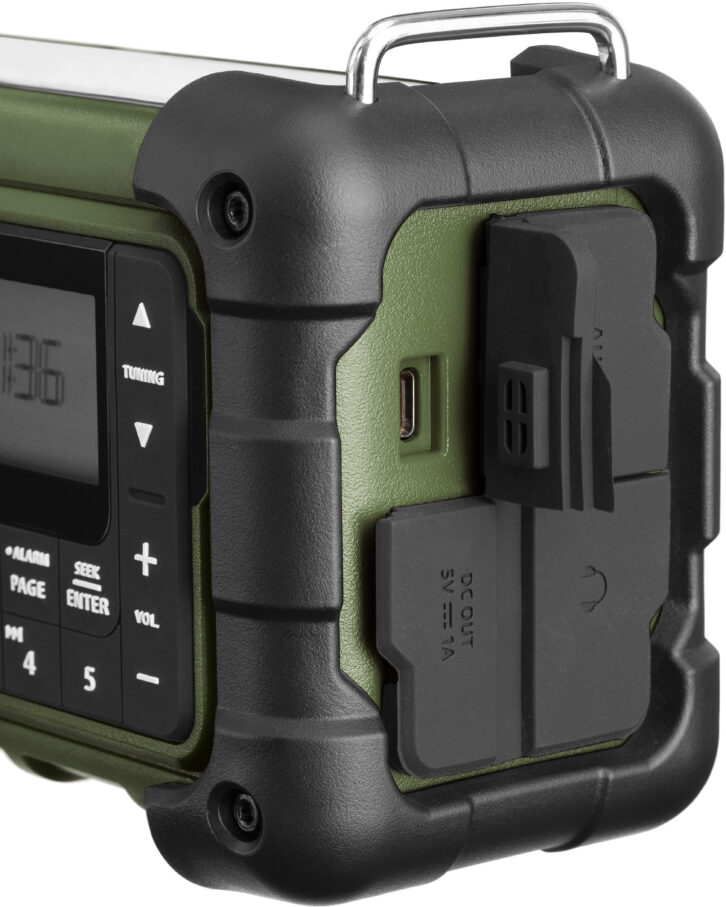
Built to take it
The company is building on the success of its earlier MMR-88 emergency model.
“The MMR-99 is the upgraded higher and better version, where new features and functions are added,” said Samuel TJ Ho, a company marketing specialist.
“We are covering the outdoor and emergency radio markets with it, knowing that there are so many unexpected events one has to be prepared for. At the same time, the MMR-99 is also for those people who want to have a high-fidelity radio/BT speaker with them in places where there is no AC power available for recharging.”
Hitting both targets requires balance.
[Related: “Ranking Emergency Radios for the Outdoors”]
“Since we wanted to make sure that the MMR-99’s sound quality meets Sangean’s high standards, we built its IPX55-rated dust/water-proof capability to the max — but not too high to cause the sound to be muffled,” Ho said. We noted that there is an end-mounted red flashlight in addition to two white ones of wide and narrow beam. “It was put in for preserving and improving night vision, plus reducing the light profile of a person in different dark situations,” he said. However, if the user wants to be noticed, there’s a top-mounted button for a two-tone audio alarm that will let rescuers know where they are.
The radio is tough. “The durability on the MMR-99 took a huge step up from its predecessor,” said Ho. “For instance, the reinforced bumpers on all corners not only give it a rugged look but also strong protection from potential damage from dropping and rolling.”
Serious charging options
There are emergency radios that come with rechargeable batteries that don’t hold enough power, undersized solar panels or hand-cranked generators with brittle plastic handles.
The Sangean MMR-99 has none of these problems. Its 3.7V/2600mAh rechargeable battery is big enough for hours of continuous service and to charge connected devices like smartphones during a power outage. Its solar panel is big enough to make a difference — the display indicates when solar charging is taking place — and the foldaway back-mounted crank is large and robust.
A reviewer for the website Vardagsprepping in Sweden said in a YouTube demo that he left his MMR-99 charging outdoors on a cloudy day for five or six hours and then was able to listen for more than an hour. He said a 10-minute crank gave him more than an hour.
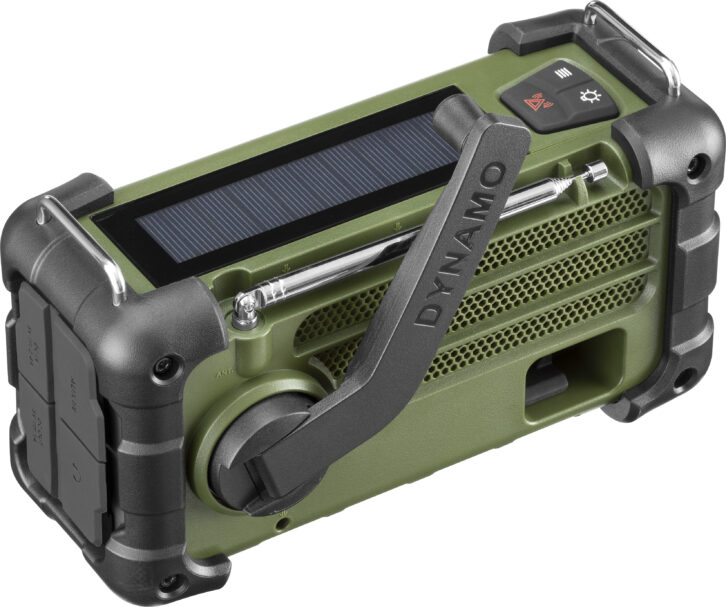
Solid sound and reception
Of course, the main reason that people buy radios — even emergency radios! — is to listen to them. And on this score, the MMR-99 also is solid. The audio out of its front-facing 2.25-inch speaker is high-fidelity on FM, Bluetooth and Aux In, and better in stereo using headsets. It was above average on AM and Weather.
Reception is aided by a 25-inch extendable, rotating whip antenna for FM/Weather and built-in ferrite rod antenna for AM, plus 40 programmable memories for presets and up/down station scanning. The big, backlit LCD display offers large-print letters and numerals that are easy to read during tuning. So are the black buttons on the front that are trimmed with raised, white-painted words and symbols.
I look for sensitivity — how a radio does at receiving weak signals — as well as selectivity — how good it is at keeping adjacent signals separated from each other for clear reception. I test on the AM band at nighttime, when signals bounce off the ionosphere and cover vast distances.
From my listening location in Ottawa, Canada, the MMR-99 had no problem picking up WCBS(AM) New York, KDKA(AM) Pittsburgh and WFED(AM) Washington, stations that range from 880 to 1500 kHz. It sifted nicely through the AM band, selecting among weak signals with a minimum of noise and interference. The background sound of the digital tuner was low, a pleasant surprise.
It would take many hours of tuning comparisons between the MMR-99 and serious AM DX performers like the Panasonic RF-2200, C. Crane CCRadio3 and GE Superadio II to assess the Sangean’s true capabilities as a long-distance AM receiver. But its performance was solid and respectable, and the directionality of the built-in AM antenna allowed me to fine-tune weak signals by rotating the radio horizontally.
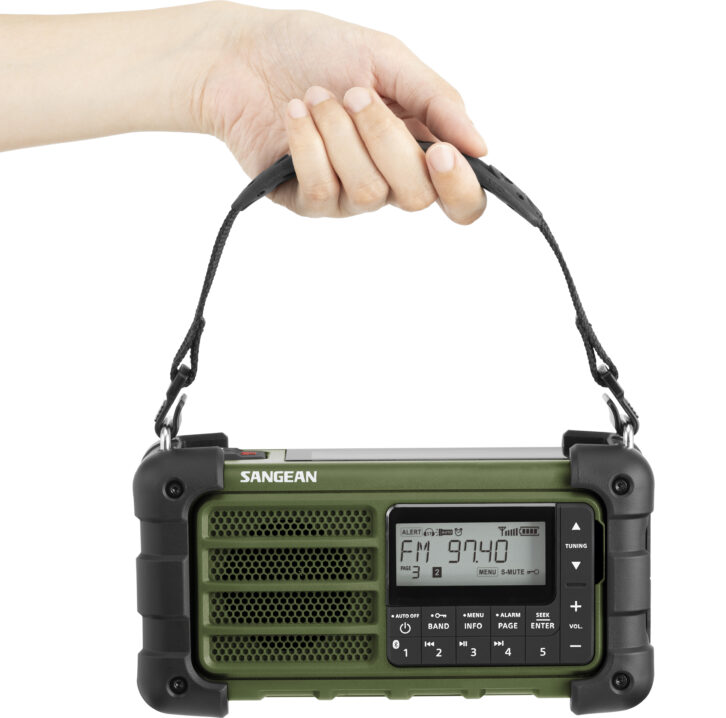
Quibbles
With these features packed into the MMR-99, it isn’t surprising that this radio is a bit hefty. At almost two pounds, it’s heavier than a conventional transistor radio.
The fact that the pushbuttons are not backlit is a problem in darkness. Apart from the fact that the radio might be used when the lights go out, part of the romance of late-night listening is tuning around in the dark.
Finally, the absence of the shortwave bands — entirely understandable from an engineering, size/weight and cost standpoint — is something that I felt.
But I labeled this section as Quibbles for a reason. None of these objections is important enough to offset this radio’s wealth of useful features nor to deny its value as a rugged, high-performing receiver.
It retails for $149.95 but was available on Amazon in June for under $100. It is also sold by Wal-Mart and many other retailers online and in-store.
The author profiled WHIV(LP) New Orleans in May.
[Check Out More Product Evaluations in Our Products Section]












